
Isopoda is an order of crustaceans. Members of this group are called isopods and include both aquatic species, and terrestrial species such as woodlice. All have rigid, segmented exoskeletons, two pairs of antennae, seven pairs of jointed limbs on the thorax, and five pairs of branching appendages on the abdomen that are used in respiration. Females brood their young in a pouch under their thorax called the marsupium.
Arubolana is a genus of isopods in the family Cirolanidae. The species of the genus are entirely adapted to living subterraneanly.
Onchotelson is a genus of isopod crustaceans in the family Phreatoicidae, which is endemic to Tasmania. It contains two species, both of which are listed as vulnerable on the IUCN Red List:
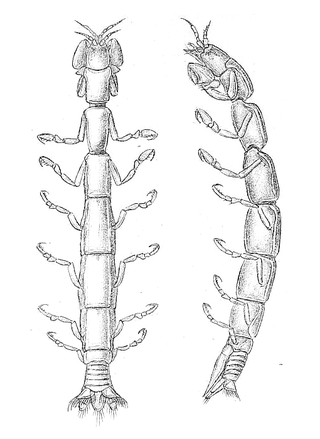
Anthuroidea is a superfamily of isopod crustaceans, formerly treated as a suborder, Anthuridea. The group is characterised by "an elongate cylindrical body form, without dorsal coxal plates, and with a uropodal exopod attached to the peduncle proximally and dorsally". There are more than 500 described species in 57 genera, arranged across six families:

The Asellidae are a family of isopod crustaceans, one of the largest families of freshwater isopods, living in both epigean and hypogean habitats in North America and Europe.

Asellota is a suborder of isopod crustaceans found in marine and freshwater environments. Roughly one-quarter of all marine isopods belong to this suborder. Members of this suborder are readily distinguished from other isopods by their complex copulatory apparatus. Other characteristics include six-jointed antennal peduncle, the styliform uropods, the fusion of pleonites 5, 4 and sometimes 3 to the pleotelson, and absence of the first pleopod in females.
Iais is a genus of isopod crustaceans. Iais species are found in association with larger isopods of the family Sphaeromatidae, usually on the ventral surface of the larger animal, between the pereiopods and on the pleopods. They are native to Australasia and South America, although Iais californica and its host Sphaeroma quoyanum have invaded California, and I. californica was first described from Sausalito, California.

The Idoteidae are a family of isopod crustaceans. It includes these genera:
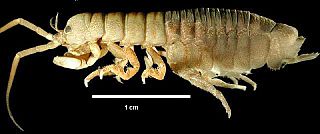
Phreatoicidae is a family of blind, freshwater isopods. They have survived apparently unchanged for 350 million years, and are only found in South Africa, India, Australia and New Zealand. They were first found near Christchurch in 1882 by Charles Chilton. The family Phreatoicidae now contains 13 genera:

Sphaeromatidea is a suborder of isopod crustaceans.
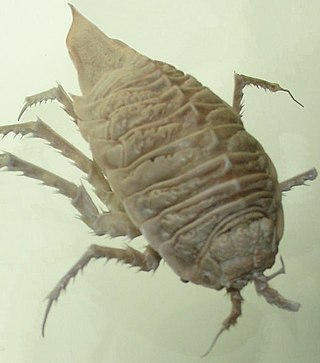
The Chaetiliidae are a family of isopod crustaceans in the suborder Valvifera, comprising these genera:

Saduria is a genus of benthic isopod crustaceans in the family Chaetiliidae, containing the following species:
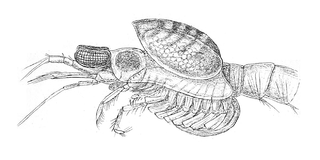
The Dajidae are a family of marine isopod crustaceans in the suborder Cymothoida. The original description was made by Giard and Bonnier in 1887. Members of this family are ectoparasites of krill. They resemble a fleshy growth on the krill's back, and make the host look as if it is wearing a rucksack. These genera are included in the family Dajidae:

The Entoniscidae are a family of marine isopod crustaceans in the suborder Cymothoida. Members of this family are parasites of brachyuran and anomuran crabs, living in their hosts' haemocoel. A small chitinised hole develops through the host's exoskeleton through which the isopod can communicate with the environment. The female isopod bears little resemblance to any free-living isopod, but the morphology of the larvae show their taxonomic affiliations.
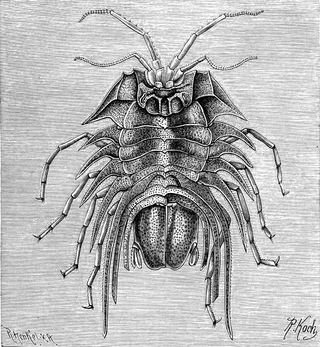
Serolidae is a family of isopod crustaceans. The family encompasses 22 genera with 109 species. These species are exclusively marine and are distributed across the marine realms as follows: one species can be found in the Temperate Northern Atlantic, one species in the Temperate Northern Pacific, seven species in the Tropical Atlantic, six species in the Central Indo-Pacific, 16 species in Temperate South America, one species in Temperate Southern Africa, 20 species in Temperate Australasia, and 31 species in the Southern Ocean.

The Arcturidae are a family of marine isopod crustaceans in the suborder Valvifera. Members of the family resemble woodlice and are found globally in cooler areas in shallow seas.
Dynoides is a genus of isopod crustaceans in the family Sphaeromatidae, containing the following species:
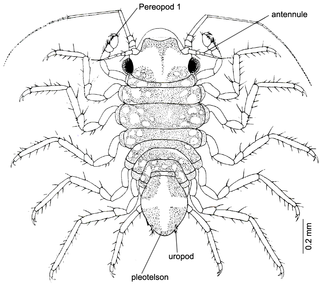
The Munnidae are a family of isopod crustaceans, containing these genera:
Holidoteidae is a family of marine isopods belonging to the suborder Valvifera.
Rectarcturidae is a family of marine isopods belonging to the suborder Valvifera.












